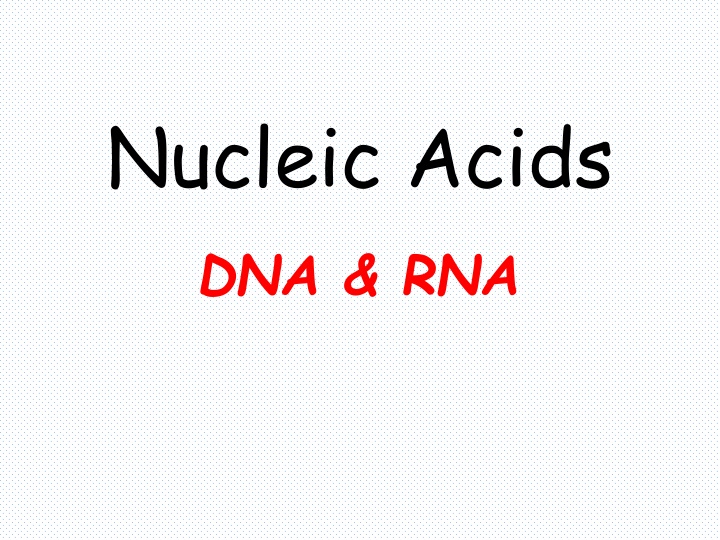
Understanding Nucleic Acids: DNA and RNA in Genetics
Explore the role of nucleic acids, DNA, and RNA in genetics, from dictating amino acid sequences to transferring genetic information across generations. Learn about replication, transcription, and translation processes, as well as the structure and function of nucleotides in eukaryotic cells.
Download Presentation

Please find below an Image/Link to download the presentation.
The content on the website is provided AS IS for your information and personal use only. It may not be sold, licensed, or shared on other websites without obtaining consent from the author. If you encounter any issues during the download, it is possible that the publisher has removed the file from their server.
You are allowed to download the files provided on this website for personal or commercial use, subject to the condition that they are used lawfully. All files are the property of their respective owners.
The content on the website is provided AS IS for your information and personal use only. It may not be sold, licensed, or shared on other websites without obtaining consent from the author.
E N D
Presentation Transcript
Nucleic Acids DNA & RNA
What do they do ? Dictate amino-acid sequence in proteins Give information to chromosomes, which is then passed from parent to offspring
What are they ? The 4thtype of macromolecules The chemical link between generations The source of genetic information in chromosomes
Nucleic Acids and Heredity Processes in the transfer of genetic information: Replication: identical copies of DNA are made Transcription: genetic messages are read and carried out of the cell nucleus to the ribosomes, where protein synthesis occurs. Translation: genetic messages are decoded to make proteins.
The nucleus contains the cells DNA (genome) RNA is synthesized in the nucleus and exported to the cytoplasm Nucleus replication Cytoplasm DNA transcription RNA (mRNA) translation Proteins
Two types of Nucleotides (depending on the sugar they contain) 1- Ribonucleic acids (RNA) The pentose sugar is Ribose (has a hydroxyl group in the 3rd carbon---OH) 2- Deoxyribonucleic acids (DNA) The pentose sugar is Deoxyribose (has just an hydrogen in the same place--- H) Deoxy = minus oxygen
Definitions Nucleic acids are polymers of nucleotides Nucleotides are carbon ring structures containing nitrogen linked to a 5-carbon sugar (a ribose) 5-carbon sugar is either a ribose or a deoxy-ribose making the nucleotide either a ribonucleotide or a deoxyribonucleotide In eukaryotic cells nucleic acids are either: Deoxyribose nucleic acids (DNA) Ribose nucleic acids (RNA) Messenger RNA (mRNA) Transfer RNA (tRNA) Ribosomal RNA (tRNA)
Nucleic Acid Function DNA Genetic material - sequence of nucleotides encodes different amino acids RNA Involved in the transcription/translation of genetic material (DNA) Genetic material of some viruses
Nucleotide Structure Despite the complexity and diversity of life the structure of DNA is dependent on only 4 different nucleotides Diversity is dependent on the nucleotide sequence All nucleotides are 2 ring structures composed of: -D-ribose (RNA) -D-deoxyribose (DNA) 5-carbon sugar : Base Purine Pyrimidine Phosphate group A nucleotide WITHOUT a phosphate group is a NUCLEOSIDE
NUCLEIC ACIDS (DNA and RNA) Notes DNA Deoxyribonucleic Acid DNA controls all living processes including production of new cells cell division DNA carries the genetic code stores and transmits genetic information from one generation to the next Chromosomes are made of DNA DNA is located in the nucleus of the cell
Nucleotides and Nucleosides Nucleotide = Nitrogeneous base Pentose Phosphate Nucleoside = Nitrogeneous base Pentose Nucleobase = Nitrogeneous base
What are they made of ? Simple units called nucleotides, connected in long chains Nucleotides have 3 parts: 1- 5-Carbon sugar (pentose) 2- Nitrogen containing base (made of C, H and N) 3- A phosphate group ( P ) The P groups make the links that unite the sugars (hence a sugar-phosphate backbone






















